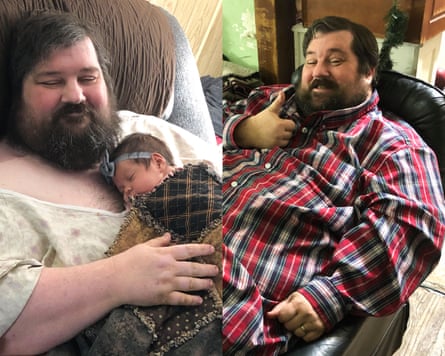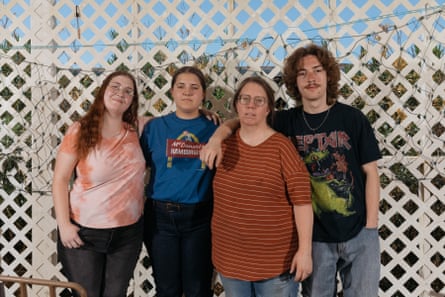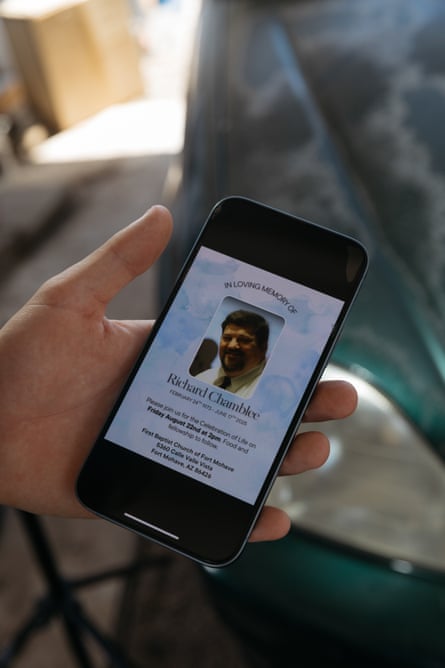It was the hottest day of the year so far when the central air conditioning started blowing hot air in the mobile home where Richard Chamblee lived in Bullhead City, Arizona, with his wife, children, and half a dozen cats and dogs.
It was only mid-June but the heat was insufferable, particularly for Chamblee, who was clinically obese and bed-bound in the living room as the temperature hit 115F (46C) in the desert city – situated 100 miles (160km) south of Las Vegas on the banks of the Colorado River.
The family could not afford to immediately replace or repair the AC system, so instead they bought a window unit and installed it next to Chamblee’s bed. They positioned fans, ice packs and cold drinks close by in an effort to keep Chamblee cool and hydrated, and they checked in on him every couple of hours.
But the mobile home is old, open-plan and poorly insulated. Despite their efforts, the temperature hovered close to 100F in the house, according to Chamblee’s son John.
Chamblee overheated and struggled to breathe. His core temperature measured 108F when he was rushed to the emergency room, but doctors were unable to cool him down, according to the death report obtained by the Guardian using the Freedom of Information Act (Foia). Chamblee’s heart stopped working.

He had died just two days after the AC went out.
“It was the end of the day and it was cooling off slightly, so we thought he’d be OK. He thought he would be OK,” said his wife, Sherry Chamblee, who works three jobs including as assistant manager at a local grocery store. “We had no idea the heat could be so dangerous so quickly inside. It just happened so fast.”
Chamblee was just 52 years old. He was a devout Baptist, smart and happy-go-lucky, and he loved playing video games.
“We did our best to cool him down, but we live a couple of hours from Death Valley, the hottest place on Earth, and my dad couldn’t move,” said John, 21. “My mom lives paycheck to paycheck and if the AC breaks down in the summer and you can’t afford to fix it, you will die here. My dad proves that.”
Nationwide, one in five of the lowest-income households have no access to air conditioning, while 30% rely solely on window units, according to exclusive analysis by the National Energy Assistance Directors Association (Neada) for the Guardian.
As many as 60% of American households live paycheck to paycheck, while one in three report forgoing basic necessities such as food or medicine to pay energy bills and avoid disconnection.
Heat is the deadliest weather phenomenon in the US and globally, killing almost half a million people worldwide each year, according to the World Health Organization. The death toll is rising as human-caused climate crisis drives more frequent, more brutal and longer heatwaves.
Last month marked 30 years since what was then an unprecedented five-day heatwave in Chicago that killed more than 730 people and sent thousands to hospital. The majority were elderly, Black, isolated, low-income residents either lacking air conditioning or the money to run it.
Since then, deadly heat domes have hit every corner of the country, including northern states unaccustomed to extreme heat, such as Oregon and Massachusetts. Yet the US has failed to implement a robust methodology to count and understand the scale of the heat-related illnesses and deaths.

As the planet heats up, experts warn that indoor heat deaths among elderly, sick and low-income people could surge amid deepening financial hardship driven by Donald Trump’s energy policies, trade wars and his administration’s dismantling of the social safety net.
“The United States is being governed by a regime that depends on denying scientific findings from climate science to economics and medical science to sociology,” said Eric Klinenberg, the author of Heat Wave: A Social Autopsy of Disaster in Chicago and director of the Institute for Public Knowledge at New York University.
“We’re not just failing to protect vulnerable people, we’re actively making life here more precarious. And while some will be able to buy their way out of the problem, most people can’t. This is an existential crisis,” said Klinenberg.
Energy poverty in the world’s richest country
One in three American households experiences energy poverty – the inability to access sufficient amounts of energy due to financial hardship, according to one recent study.
And it’s getting worse. The average household electric bill during the summer months, when cooling drives up usage, will reach $784 in 2025 – a 6.2% rise from $737 last year, according to analysis by Neada for the Guardian. This will be the highest recorded in more than a decade, and will place a disproportionate burden on low-income Americans. Families in the south and south-west are disproportionately affected.
The Chamblee family experienced severe energy poverty until 2023, when they saved $1,000 to install residential solar panels that qualified for tax credits, and cut the family’s summer electricity bills from around $400 to $60 a month. The federal solar tax credit included in Biden’s Inflation Reduction Act ends in December, however, thanks to Trump’s One Big Beautiful Bill Act – a decade earlier than planned.
Trump’s budget will lead to residential electricity bills in Arizona increasing by $220 on average by 2035, by truncating the development of new, cost-effective solar energy capacity in the sunny state, according to analysis by Energy Innovation. Trump’s signature legislation will also slash access to food stamps and healthcare, relied upon by millions of low-income households, in order to fund tax cuts for the wealthy.

Nationwide, meanwhile, his unprecedented and chaotic rollback of federal incentives and permits led to the cancellation of $22bn of clean energy projects in the first six months of 2025, more than half in Republican states.
Earlier this month, Arizona’s Republican-controlled regulator also voted to begin the process of repealing the state’s renewable standard, which required that at least 15% of utility energy supplies should come from renewable sources by 2025. Consumer and environmental advocates – and the state’s attorney general – warn the move will further drive up energy bills.
And in Arizona and across the country, private utilities have submitted proposals for multibillion-dollar rate increases, in order to cover infrastructure upgrades, inflation and new fossil fuel projects – driven, at least partially, by the unchecked expansion of massive datacentres promoted by the Trump administration.
“Families are already struggling with high energy bills, and forcing them to cross-subsidize some of the world’s wealthiest corporations violates both fairness and common sense,” said Mark Wolfe, an energy economist and director of Neada.
“It will worsen energy poverty, erode public trust, and turn utilities into vehicles for corporate welfare.”
Taylor Rogers, a White House spokesperson, dismissed criticism of Trump’s energy policy as “fearmongering”.
“The best source of energy in a heat wave is baseload energy from coal and natural gas, which the president has unleashed and made more affordable, not intermittent energy sources like solar,” Rogers said. “By increasing energy production, eliminating burdensome regulations, and streamlining permitting, President Trump is ensuring that US energy meets the energy demands for heat waves, data centers, and grid stability.”
Energy … on the credit card
Household utility debt is reaching crisis levels, jumping from $17.5bn in January 2023 to $21bn in June 2025 and forecast to climb as high as $25bn by the end of this year. Currently, only 26 states and the District of Columbia have rules restricting some utility shutoffs over the summer, and disconnections could hit 4m by the end of 2025, according to Neada.
Amid soaring energy costs, shrinking federal aid, hotter summers and a zip code lottery when it comes to utility disconnection rules, health experts warn that households on fixed incomes and those with medical issues such as diabetes, heart disease, obesity and addictions will be most vulnerable.
“These are preventable deaths, and the situation is going to get worse as bills go up and hardship increases,” said Vjollca Berisha, a former senior epidemiologist at the Maricopa county department of public health who tracked energy insecurity and indoor deaths. “It only takes a little push to knock down people with underlying conditions if they don’t have options.”

In Maricopa county, which includes Phoenix, last year, almost a quarter of the 608 confirmed heat-related fatalities happened inside, with people over 50 accounting for the vast majority of those who died at home.
A quarter of the county’s indoor deaths took place in RVs or mobile homes, a popular source of affordable housing, especially for retirees, but which are often poorly insulated and too rundown to qualify for weatherization programs.
The vast majority of those indoor heat victims had AC at home, but the unit was broken in 70% of cases – while one in 10 had no electricity to run even a fan, according to Maricopa county’s 2024 report.
Patricia Miletich, a 70-year-old woman with memory issues, died in June 2024 at a 55+ RV resort with pickleball courts, a golf course and bistro in the hot and dusty city of El Mirage north-west of Phoenix. According to her autopsy report obtained by the Guardian using Foia, a neighbor told death investigators that Miletich had forgotten to pay her bills on multiple occasions, resulting in her electricity being turned off in the past.
The power was on when she died, but the AC was not functioning. Like Chamblee’s, it blew hot air from the vents, between 109F and 117F. The resort’s manager confirmed to the Guardian that Miletich’s power had been disconnected several times, but declined to answer further questions about what support the retiree received.
“It’s a sad situation that should never have happened, but she wanted to be left alone and the family didn’t know” about her memory decline and electricity shutoffs, said her brother Michael Miletich.
In nearby Mohave county, a Guardian analysis of death reports obtained under Foia found that 70% of the 67 confirmed heat-related deaths in 2024 occurred indoors – of which the vast majority lived in RVs or mobile homes.
This includes Stephen Patterson in Lake Havasu City, a 69-year-old with multiple health challenges tied to a childhood road traffic accident, chronic pain and alcohol addiction. Patterson relied on his $1,000 monthly social security check – the sole source of income for around 40% of seniors, according to one 2020 study.
According to Regina, his sister and main carer, Patterson rationed his AC use because he believed he could cope with the heat but not without alcohol. He also incorrectly blamed the AC for a mold issue.
When he died, the temperature inside Stephen’s house was 102F, according to the medical examiner’s report. The daily high in Lake Havasu City was 116F.

“I begged him to turn on the AC,” said Regina, who is 75 and, like her brother, is also on a fixed social security income. “I would have paid his bill on my credit card, but my brother was a stubborn man. It was like a furnace when I found him.”
Regina uses credit cards to pay her electric bill, currently $211 a month, as well as her water, trash, car insurance and cable. The cards charge as much as 35% interest. Around 60% of her monthly income covers the house payment, and the rest goes to service the credit card debt, which currently stands at more than $12,000 – in addition to almost $1,000 owed to the energy company.
She diligently documents each month’s payments and remaining credit in an A4 notebook that sits on the coffee table next to the TV remote.

Regina has been disconnected multiple times over the years, but has received some financial help from the Salvation Army and Goodwill to avoid a shutoff. Yet she was unaware of the Low Income Home Energy Assistance Program (Liheap), the chronically underfunded federal program to help families pay their energy bills, which the Trump administration proposed cutting after firing the entire workforce in April.
In Arizona, 24,000 households received Liheap assistance in the 2025 fiscal year. A third of recipients included a household member with a disability or children under six, while 16% included an older adult. Liheap was saved amid bipartisan protests, but its future remains uncertain. Arizona, where heat deaths are known to occur from April to November, currently only has enough funds to help struggling families through the end of September.
On his first day back in the White House, Trump declared a national energy emergency, promising to lower prices by boosting fossil fuels and rolling back Joe Biden’s renewable energy ambitions. To Regina Patterson, it all now rings hollow.
“The price of everything keeps going up and I get into more debt every month. Trump is evil and only cares about the rich,” she said.
“If I were to lose my electric in this heat, I would lose my head.”

 German (DE)
German (DE)  English (US)
English (US)  Spanish (ES)
Spanish (ES)  French (FR)
French (FR)  Hindi (IN)
Hindi (IN)  Italian (IT)
Italian (IT)  Russian (RU)
Russian (RU)  5 hours ago
5 hours ago
























Comments